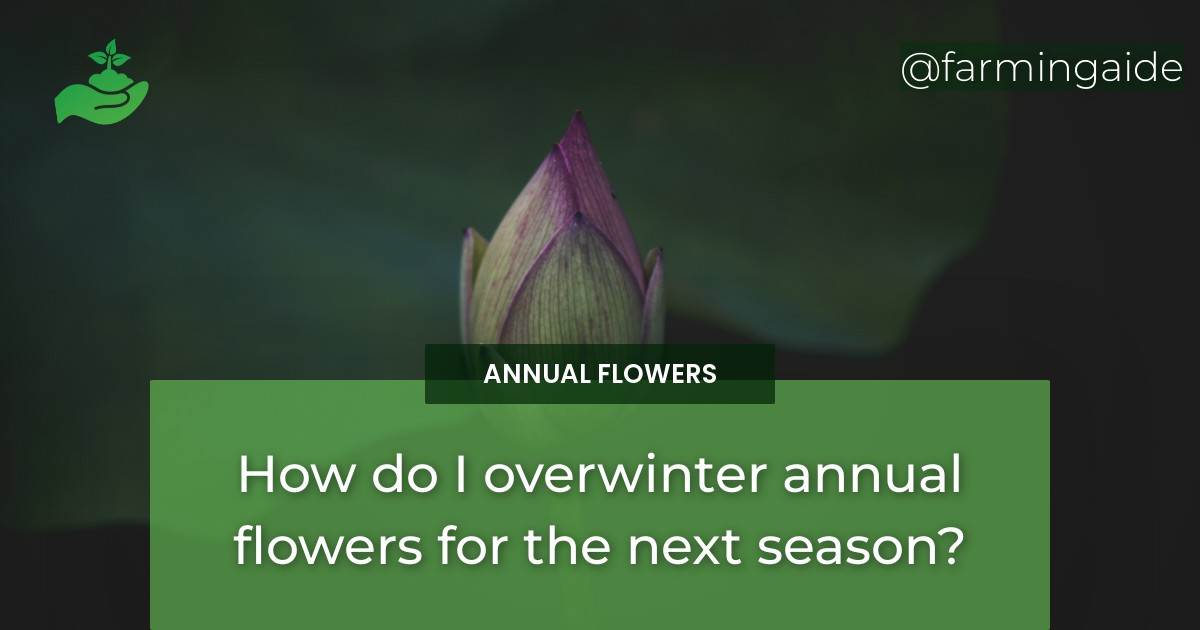Overwintering is the process of protecting annual flowers from winter’s harsh conditions and ensuring their survival for the next growing season. With this technique, gardeners can save money and time since they do not have to buy new plants every year. Besides, overwintered annual flowers may produce more significant blooms and healthier foliage, resulting in an impressive flower bed the following season. The importance of overwintering annual flowers cannot be overemphasized. However, gardeners must consider several factors before embarking on this process. This article will provide comprehensive insights into overwintering annual flowers, including its importance, factors to consider, techniques, and maintenance.
Understanding Annual Flowers
Annual flowers are plants that complete their life cycle within a year. They go from seed to mature plant, produce flowers, then seeds, and then die. While most annual flowers are sensitive to cold weather, others can withstand frost and snow. Therefore, it’s important to understand your plant’s characteristics before overwintering to avoid unnecessary stress that could damage or kill them.
Importance of Overwintering Annual Flowers
Overwintering annual flowers has several benefits:
- Saves money and time.
- Ensures plants are adapted to your garden soil and conditions.
- Produces more significant blooms and healthier foliage.
- Preserves plant genetics.
Factors to Consider Before Overwintering Annual Flowers
Plant Hardiness
Plant hardiness is the ability of a plant to withstand cold weather. Before overwintering, check the plant’s hardiness zone, which refers to the lowest temperature a plant can survive in winter. Choose plants that are hardy in your zone to increase their chances of surviving winter’s cold.
Soil Type
Soil type is another crucial factor to consider before overwintering annual flowers. Well-draining soil is ideal since it prevents root rot, which could kill the plants. If your garden’s soil is heavy and clayey, consider adding organic matter like compost to improve drainage.
Sun Exposure
Annual flowers require sunlight to produce energy through photosynthesis. Therefore, choose a location that receives enough sunlight for your plants to thrive. Lack of sunlight can result in spindly growth and weak foliage, making the plants more susceptible to winter damage.
Watering Requirements
Watering requirements vary among different annual flowers. Some require more water than others. Before overwintering, ensure that your plants are well-hydrated. Overwatering or underwatering could stress the plants and make them vulnerable to winter damage.
Techniques for Overwintering Annual Flowers
Mulching
Mulching is the process of covering the soil surface around the plants with organic matter like straw, leaves, or bark. Mulching helps retain soil moisture, regulate soil temperature, and prevent frost heave, which could expose plant roots to cold air. Apply a 2-3 inch mulch layer around your plants to protect them from winter’s harsh conditions.
Creating a Microclimate
A microclimate is a small area within a larger environment that has different climatic conditions. Creating a microclimate involves using barriers like trellises, walls, or fences to protect plants from winter winds and cold temperatures. You can also use protective covers like plastic sheets or fabric blankets to shield plants from frost and snow.
Transplanting
Transplanting involves moving annual flowers to a container and bringing them indoors before winter sets in. This technique is ideal for tender annual flowers that cannot survive winter temperatures. Ensure that the container has adequate drainage holes and is located in a well-lit area.
Using Cold Frames
A cold frame is a simple structure made of wood or metal that has a transparent lid or cover. The lid traps heat from the sun, creating a warm environment for plants inside. Cold frames are ideal for hardy annual flowers that can withstand low temperatures but require protection from winter winds and snow.
Bringing Indoors
Bringing plants indoors is an effective way of protecting them from winter’s harsh conditions. Choose a location indoors that receives enough sunlight and provides the right temperature and humidity levels for your plants to thrive.
Rooting Cuttings
Rooting cuttings involves taking stem cuttings from your annual flowers and rooting them in water or soil. This technique is ideal for preserving your favorite annual flowers and ensuring that you have new plants for the next growing season. Take cuttings from healthy plants, dip them in rooting hormone, and place them in water or soil.
Maintenance of Overwintered Annual Flowers
Watering
Water your overwintered annual flowers sparingly to prevent root rot. Ensure that the soil is well-draining and that the container or bed has adequate drainage. Overwatering could stress the plants and make them vulnerable to pests and diseases.
Pruning
Prune your overwintered annual flowers to maintain their shape and size. Remove any dead or diseased leaves and stems to prevent the spread of diseases. Prune the plants in early spring before new growth appears.
Fertilizing
Fertilize your overwintered annual flowers to promote healthy growth and blooming. Use a balanced fertilizer with equal amounts of nitrogen, phosphorus, and potassium. Fertilize the plants in early spring when new growth appears.
Will Deadheading Annual Flowers Help Them Survive the Winter and Bloom Again?
Deadheading annual flowers for more blooms can help them survive the winter and bloom again. Removing the spent flowers redirects the plant’s energy into producing new blooms, keeping it healthy and promoting continuous flowering. This simple practice can prolong the beauty of annual flowers and ensure a splendid display.
Conclusion
Overwintering annual flowers can be a rewarding experience for gardeners who want to save money and time. However, it requires careful consideration of plant hardiness, soil type, sun exposure, and watering requirements. Gardeners can use several techniques like mulching, creating a microclimate, transplanting, using cold frames, bringing indoors, and rooting cuttings to overwinter their annual flowers. To maintain healthy and blooming plants, gardeners should water sparingly, prune regularly, and fertilize in early spring.


